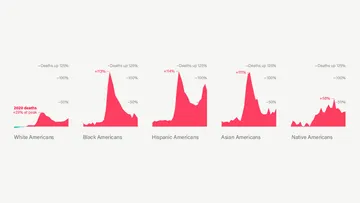The Marshall Project spent a year investigating how police enforce gun laws in Chicago. The city has some of the strictest firearm regulations in the country, while simultaneously facing persistent high levels of gun violence.
Here are five takeaways from our story:
Gun enforcement is geared toward illegal gun possession that disproportionately affects young Black men.
We analyzed gun arrests Chicago police made from 2010 to 2022. We found that the majority of these arrests are for illegal possession — not firing a gun.
Our reporting also identified glaring racial disparities in who gets caught up in this enforcement. More than 8 in 10 of those arrested for possession are Black — despite making up less than a third of the city’s population. The number of Black people arrested could fill every seat at a Chicago Bulls game or Madison Square Garden. The majority are men in their 20s and 30s.
These arrests have increased substantially in recent years, even as the overall number of arrests police make has sharply declined.
These arrests often begin with a traffic stop.
To better understand how possession-based gun enforcement works in practice, we examined more than 225 gun arrests conducted over last year’s Memorial and Labor Day weekends. These holiday weekends tend to have increased police presence.
Reports show that in more than 140 cases, illegal gun possession was the most severe charge. We found that 7 in 10 of these incidents began with a traffic stop. The infractions were often something mild like having expired license plates, failing to use a turn signal or double-parking. After this initial stop, police often cited the smell of marijuana to justify searching the person’s belongings. Illinois legalized cannabis in 2020, but it’s still illegal to use while driving.
This strategy to seize guns isn’t isolated to Chicago; it’s been observed in Philadelphia and Baltimore, too.
In Chicago, we found that even after conducting thousands of traffic and pedestrian stops, police yield a small amount of firearms. Over the course of Memorial Day weekend last year, for instance, we found that police stopped more than 6,500 people over the course of a few days. They seized about 130 guns in possession arrests.
Arresting more people for gun possession did not substantially reduce gun violence.
Officials justify the focus on confiscating guns — even if they are not being fired at anybody — as a way of curtailing violence. But these tactics have not substantially reduced shootings in Chicago. In fact, as possession arrests skyrocketed, shootings increased — but the percentage of shooting victims where someone was arrested in their case declined.
Police often step up gun possession enforcement following spikes in violence, but we found that since 2010, they have failed to make an arrest in more than 8 in 10 shootings.
Other cities have similar racial disparities in gun possession arrests.
We found that these disparities exist regardless of a city’s homicide rate or the strictness of their gun laws.
In New York City, which has some of the strictest gun laws in the country, our analysis found that in the past decade, Black people were almost 70% of those arrested for gun possession, despite being about 20% of the city’s population.
In Houston, our analysis shows that arrests for illegal possession jumped more than 70% between 2019 and 2021. Black people comprised more than 6 in 10 of those arrested, despite making up less than a quarter of the city's residents.
In Cleveland, where last summer the state made it legal to carry a concealed gun without a permit, Black people accounted for nearly 90% of those arrested.
The Houston, Cleveland, Baltimore and Memphis police departments did not respond to our findings. In a statement, the NYPD said it did not engage in “racially-based” enforcement and that policing efforts are based on several factors, including where crime is concentrated. The Philadelphia Police Department said the agency has piloted programs to limit racial disparities in “low-level” arrests following a 2011 class-action settlement about stop-and-frisk tactics.
These problems have existed for decades.
Like many systemic issues, racial disparities in gun enforcement isn’t new. A review of annual crime reports published by the Chicago Police Department from 1964 through 2022 shows that for nearly 60 years, most people arrested for violating Illinois’ weapons laws in the city were Black, even as their share of the city’s population rose and fell.
Many pivotal gun laws were passed with the intent to disarm Black communities. Even today, when gun laws are not explicitly racist, researchers say they can still have racist outcomes.
“Chicago is a really telling example where there is a legitimate gun violence problem, and legitimate efforts to try to correct that problem — but they run headlong into American traditions of racial discrimination,” said Adam Winkler, a Second Amendment historian and law professor at UCLA.
Read our story examining gun law enforcement in Chicago and across the country.
A previous version of this story misstated the extent of the firearm law instituted in Cleveland last summer. Ohio made it legal, statewide, to carry a concealed gun without a permit.
